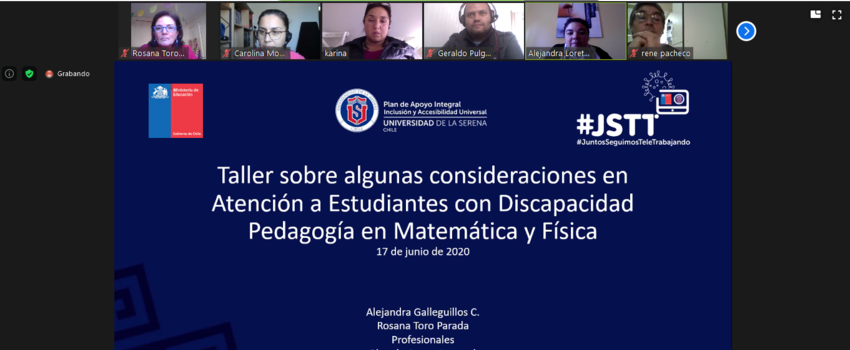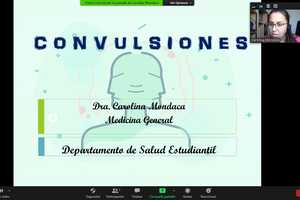- News
Professors of the Mathematics and Physics Pedagogy career deepen strategies to deal with students with disabilities

The instance is part of the support actions implemented by the Comprehensive Support Plan, focused on providing guidance to the teachers of the school, on matters of inclusion.
Three major themes were discussed in the workshop aimed at teachers of the Pedagogy in Mathematics and Physics career, with the purpose of addressing those needs presented by the students who make up the Comprehensive Support Plan. On this occasion, they reflected on autism spectrum disorder, visual impairment and seizures.
In the first instance, Dr. Carolina Mondaca (ULS Health Department) discussed the main guidelines for knowing how to act in the event that a student presents a seizure crisis. “Among the causes of seizures, epilepsy is generally found, but it is not the only one, since they can also be caused by acute diseases, such as meningitis; drug or alcohol poisoning; a trauma generated in the skull area; biochemical disorders, such as type 1 diabetes; or high fevers,” she explained.
Regarding seizures caused by epilepsy, the professional pointed out that there are various types, which can be differentiated by observing the stereotyped movements manifested by the student. They can be defined according to the seizure status, that is, a person who has a seizure for more than 30 minutes or repeated seizures without regaining consciousness, these necessarily require specialized equipment immediately. Likewise, those crises classified as complex partial, in which the person cannot control movements, also require urgent medical management.
“If they are faced with a seizure, they always have to keep the person on their side so that the fluids are passively evacuated from the mouth; As they are stiff, all tight clothing must be released so that the body can breathe from the convulsive crisis; They must clear any risky objects from the area; No objects should be put in your mouth or liquids should be given to you; You do not have to hold them or immobilize them, you have to let them have the seizure calmly, because they can cause muscle damage; you should keep the person close, soften surfaces or put them on your lap; and after the crisis the person should be allowed to rest. It is advisable to take the time from when the seizure begins, as this information is important for the medical team,” he expressed.
Finally, he announced the acronym “AVDI”, which can help teachers or officials recognize when urgent medical assistance is required. “A means that the patient is alert and can answer questions spontaneously, fluidly and lucidly; V implies that he responds only to verbal stimuli, and they remain in a state between asleep and conscious; These two cases are manageable within the classroom. The acronym D means that she responds only to painful stimuli; and the I is that he is unconscious; Therefore, you need to ask for help.”
Guidance for students with visual disabilities
On the other hand, psychologist Rosana Toro provided some suggestions that teachers should consider if they have students with visual disabilities, which may be total blindness or low vision. “When we go to greet, we must introduce ourselves at first contact, indicate if you are alone or if you are with another person, and tell the student if he or she has to sit down. In a conversation with a student with a visual disability, you must speak directly to him or her even when he or she does not see you, speak by name, never address the person accompanying him or her, always speak to the student and look at his or her face, use a normal tone, slowly and clear. Always ask him if he needs help, offer him his hand, his shoulder, and point out the objects around him,” she stated.
Regarding eliminating barriers to learning, the psychologist explained that it is important to allow students to use a recorder, provide notes or texts in advance and that these are in a digital format that allows the reading of specialized software; use texts in Arial or Verdana type, in size 12 or 14, with a normal or semi-bold font; Use images with little detail and that are easy to describe.
Autism Spectrum Disorder (ASD)
Finally, differential educator Alejandra Galleguillos referred to students who have some level of autism spectrum disorder. “ASD is not a disease, but a condition that evolves throughout the person's life century and that mainly leads to a deficit in communication and social interaction, and it is common to observe repetitive patterns in interests or activities (…) are “people who mostly like to be alone, who avoid social and visual contact, their body language is not very assertive, they have a hard time reading the context, and they have difficulty using their imagination in learning processes,” he clarified.
In relation to the university environment, according to a study it was determined that the majority of students do not report their condition, for fear of the prejudices that this may lead to; 39% do not have a diagnosis before arriving at the University; 60% enter motivated by a desire to study and interest in working; 40% enter to escape their situation of origin; and 50% of students feel that they did not fit into the educational system.
Therefore, within the recommendations to follow, it is suggested to support the student's self-regulation, that is, letting them leave the room if they need to, since they tend to look for quiet places with few stimuli when they become decompensated.
In order to minimize the barriers to social participation, it is suggested to listen and believe what they are saying, send concrete, short and precise messages, not speak in double meanings, and if irony or jokes are used, explain them once they have been said. Regarding learning, the teacher can provide a class structure, constantly repeat the main points, recapitulate or summarize at the end of classes, explain literally, offer complementary information, encourage self-control and collaborative work.
At the end of each presentation, the teachers had the opportunity to clarify all their concerns to know how to act if they witnessed any of these situations.
Written by Daniela Ledezma, Comprehensive Support Plan
